Wedding Enquiry
Please fill wedding enquiry form Below and a member of our team will be in contact as soon as possible.
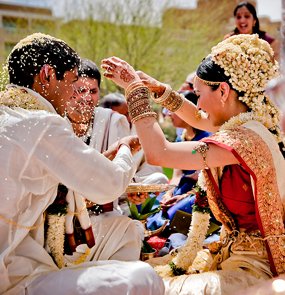
Like the ceremonies of various other communities, Kannada wedding too lasts for a week, including the pre-wedding rituals, wedding rituals, and post wedding rituals. The pre-wedding rituals commence with the Nischay Tamulam ceremony wherein the family fixes the date of marriage. Then the Haldi ceremony takes place, wherein turmeric paste is applied to both bride and bridegroom in their respective houses. Amongst the pre-wedding rituals, the most unique one is Kashi Yatra Tradition, which usually happens at the groom's house. In this custom, the groom acts as if he is leaving the house to visit Kashi to find a suitable wife; then he is stopped by his maternal uncle who tells him that the bride is already selected. Before leaving for the wedding venue, groom's family conducts a Dev Karya Ceremony, during which they pray to Lord Ganesh.
Like the ceremonies of various other communities, Kannada wedding too lasts for a week, including the pre-wedding rituals, wedding rituals, and post wedding rituals. The pre-wedding rituals commence with the Nischay Tamulam ceremony wherein the family fixes the date of marriage. Then the Haldi ceremony takes place, wherein turmeric paste is applied to both bride and bridegroom in their respective houses. Amongst the pre-wedding rituals, the most unique one is Kashi Yatra Tradition, which usually happens at the groom's house. In this custom, the groom acts as if he is leaving the house to visit Kashi to find a suitable wife; then he is stopped by his maternal uncle who tells him that the bride is already selected. Before leaving for the wedding venue, groom's family conducts a Dev Karya Ceremony, during which they pray to Lord Ganesh.

Weddings in Tamil community are simple and pious. Panda Kaal Muhurtham marks the commencement of the wedding wherein bride and groom prays for the peaceful marriage ceremony. Then Sumangali Prarthanai is performed, the bride takes blessings from Sumangali women (the women who die before their husband) so that she also becomes one of them. Then the Pallikal Thellichal wherein seven earthen pots brimming with curd, and gain is immersed in the water. It is done to take the blessings from fish. And then Nichayathartham takes place during which the bride prays Lord Ganesha. During the Nichayathartham ceremony, the bride and groom also exchange rings.
On the main day of the wedding, the rituals commence with Mangala Snaanam wherein the relatives and friends apply a paste of oil, turmeric, and kumkum on the bride and the groom. And then they are taken for the purifying bath. After the Mangala Snaanam there's Kasha yatra during which groom pretends as if he is going to Kashi Yatra to forsake marital bliss. As he embarks on this journey, the bride's father intervenes, and persuade him to alter his mind. If the groom accepts the marriage proposal, he goes to the mandap. Once he reaches the mandap, the Pada Puja takes place, and bride's mother washes the feet of the groom. Oonial ritual is next in line wherein bride and groom sit on the swing to eat and banana and milk while the relatives and friends keep on throwing rice balls on them to keep the fun alive. Then both the bride, and groom are escorted to Mandap to follow the further ceremonies - Kanyadanam, Muhurtham, and Saptapadi. All these ceremonies are followed by Bidaai during which the bride leaves the paternal home to go to her in-law's place. And that's how the Tamil wedding ceremony comes to an end.

The wedding rituals of the Telugu wedding commences a day before the marriage with Pendlikoothuru in which friends and relatives apply the paste of turmeric on the hands, feet, arms, legs and face of the bride and the groom and bless them as they gear up for their big day. This is followed by the ritual of Kashi Yatra, as per which the groom pretends to leave for Kashi but interrupted by bride's brother. In the morning, on the wedding day, the bride, and groom performs the Mangala Snanam ritual, in which they take a holy purifying bath. Following this is Gauri puja, which is done by the bride to seek the blessings of Mother Goddess. Meanwhile, the groom performs the Ganesh Puja.
At the wedding venue, the bride is escorted by her maternal uncle to the mandap. The couple sits opposite to each other, and a curtain is then placed between them to prevent from sneaking a look at each other. Then the Kanyadaan ritual is performed by the father of the bride. The curtain is lowered down only to perform the mangalsutra ceremony. After this, the couple exchanges garlands and are showered with flowers and yellow color rice. Next ritual in line is Saptapadi, wherein the couples take seven rounds around the fire, and vows to stay together in thick and thins throughout life. Subsequently, the groom slips silver toe rings on bride's feet. And then comes the 'Bidaai', the last ceremony of the wedding when the bride leaves her place of birth, her home, her loved ones and go to a new home & life that awaits her.

Malayalee wedding starts off with Muhurtham Ritual, this is when a priest decides the pre-wedding and wedding dates and time. Next ceremony is Nischayam in which elders of the family make an announcement but no prospective groom and bride are allowed to attend the event. On the day before the marriage, a five-course feast is prepared at the bride s house. The bride wears fine jewelry and silk saree. She is then made to sit facing the east. A function in the similar pattern takes place at the groom's house as well.
On the day of the wedding, both the bride and bridegroom receive the blessings of elders by giving Dakshina. Then they leave for the venue. At the venue, bride s brother washes the groom s feet and invites him to the Kalyana Mandap. The bride is escorted by her aunt to the Kalyana Mandap. Once she sits next to the groom, the nadaswaram plays in the background. And then the priest performs the nuptial ceremony by chanting Vedic mantras. The couples walk around the fire and then ties the mangalsutra on bride s neck. Also, the groom gifts her bride a saree conveying to her that he will now assume the responsibility of providing for her life. This followed by an exchange of garland ceremony. The bride s father places her right hand in the right hand of the bridegroom, symbolically transferring the responsibility of taking care of his daughter, in holy matrimony. After the sadhya (feast of 25 dishes), the bride bids farewell to her family, and the wedding ceremony comes to an end.

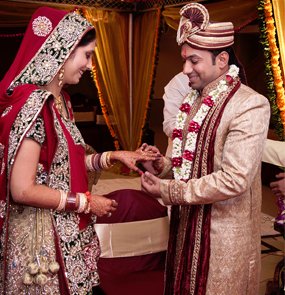
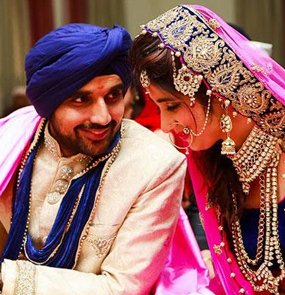
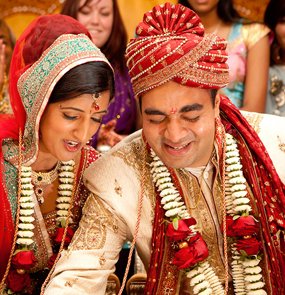
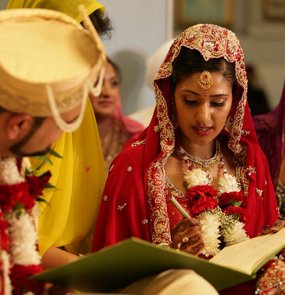
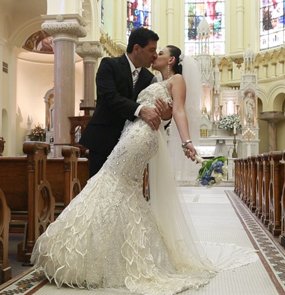
Please fill wedding enquiry form Below and a member of our team will be in contact as soon as possible.